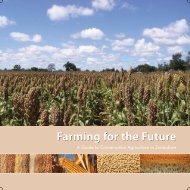Restoring the Soil - Canadian Foodgrains Bank
Restoring the Soil - Canadian Foodgrains Bank
Restoring the Soil - Canadian Foodgrains Bank
Create successful ePaper yourself
Turn your PDF publications into a flip-book with our unique Google optimized e-Paper software.
60Green Manure/Cover Crop Systemsshould <strong>the</strong>refore also teach <strong>the</strong> community to winnow <strong>the</strong> grain as Asians do <strong>the</strong>ir riceand o<strong>the</strong>r small grains.S10. Tomatoes/jackbeans. Jackbeans are intercropped in <strong>the</strong> rows between tomatoplants. They are usually planted at <strong>the</strong> same time as <strong>the</strong> tomatoes. When <strong>the</strong>y begin toshade <strong>the</strong> tomatoes, <strong>the</strong>y are pruned back to a height of about 30 to 40 cm, whichforces <strong>the</strong>m to sprout more branches and grow laterally ra<strong>the</strong>r than vertically. Atmost one hundred farmers use this practice that was developed in Yucatan during <strong>the</strong>1980s.S11. Chili peppers/jackbeans. Jackbeans are managed in chili pepper fields in Yucatan<strong>the</strong> same way as in <strong>the</strong> tomato fields in S10.GuatemalaS12. Maize/runner bean-1. In <strong>the</strong> Department of San Marcos, scarlet runner beansare intercropped very sparsely with maize. The runner beans produce a good deal oforganic matter. Since <strong>the</strong>y are climbers, <strong>the</strong>y can cause <strong>the</strong> maize to fall over toward<strong>the</strong> end of <strong>the</strong> growing season. Therefore, farmers tend to plant it quite sparsely, usingas few as one or two seeds in each 3 m x 3 m sector. The runner bean is planted at <strong>the</strong>same time as <strong>the</strong> maize. At least 3,000 to 5,000 farmers use this traditional system.This “problem” of <strong>the</strong> production of a massive amount of organic matter by <strong>the</strong> runnerbean could be a tremendous advantage in terms of soil fertility and productivity. Isuspect that if <strong>the</strong> runner bean and maize could be supported by a third, fast-growing,woody-stemmed plant (perhaps tephrosia?), <strong>the</strong> system could become one of <strong>the</strong> mostprofitable and sustainable highland maize-growing systems anywhere. This possibilityneeds to be researched.S13. Maize/runner bean-2. In <strong>the</strong> central highlands a variety of runner bean is intercroppedmuch more densely with maize (up to one seed for every 2 square metres)(Photo 19). Maize yields have been maintained for up to 20 years in many placeswith this system. Before <strong>the</strong> Europeans arrived, similar systems were apparently usedin virtually all <strong>the</strong> temperate or highland areas from New York State in <strong>the</strong> UnitedStates, south to Mexico, Guatemala, Honduras, Colombia, Ecuador, Peru, Bolivia andnor<strong>the</strong>rn Chile. Hundreds of thousands of farmers, stretching from Mexico to Bolivia,use this system today.S14. Maize/mucuna-4. Mucuna is rotated with maize in <strong>the</strong> Cerro San Gil region,Department of Izabal (Photo 31). The maize is planted when <strong>the</strong> rains start in Mayor June, and mucuna is relay-cropped into <strong>the</strong> maize 30 to 40 days before <strong>the</strong> maize isharvested (Photo 32). Maize following mucuna, without chemical fertilizer, has producedup to 7.4 MT/ha on Brazilian experimental stations. 16 This is evidence of <strong>the</strong>potential yields that can be achieved by rotating or relaying mucuna with maize. Thissystem is also used in Nicaragua and Brazil. In Paraguay some farmers wait to plant16Lathwell, op. cit.
















